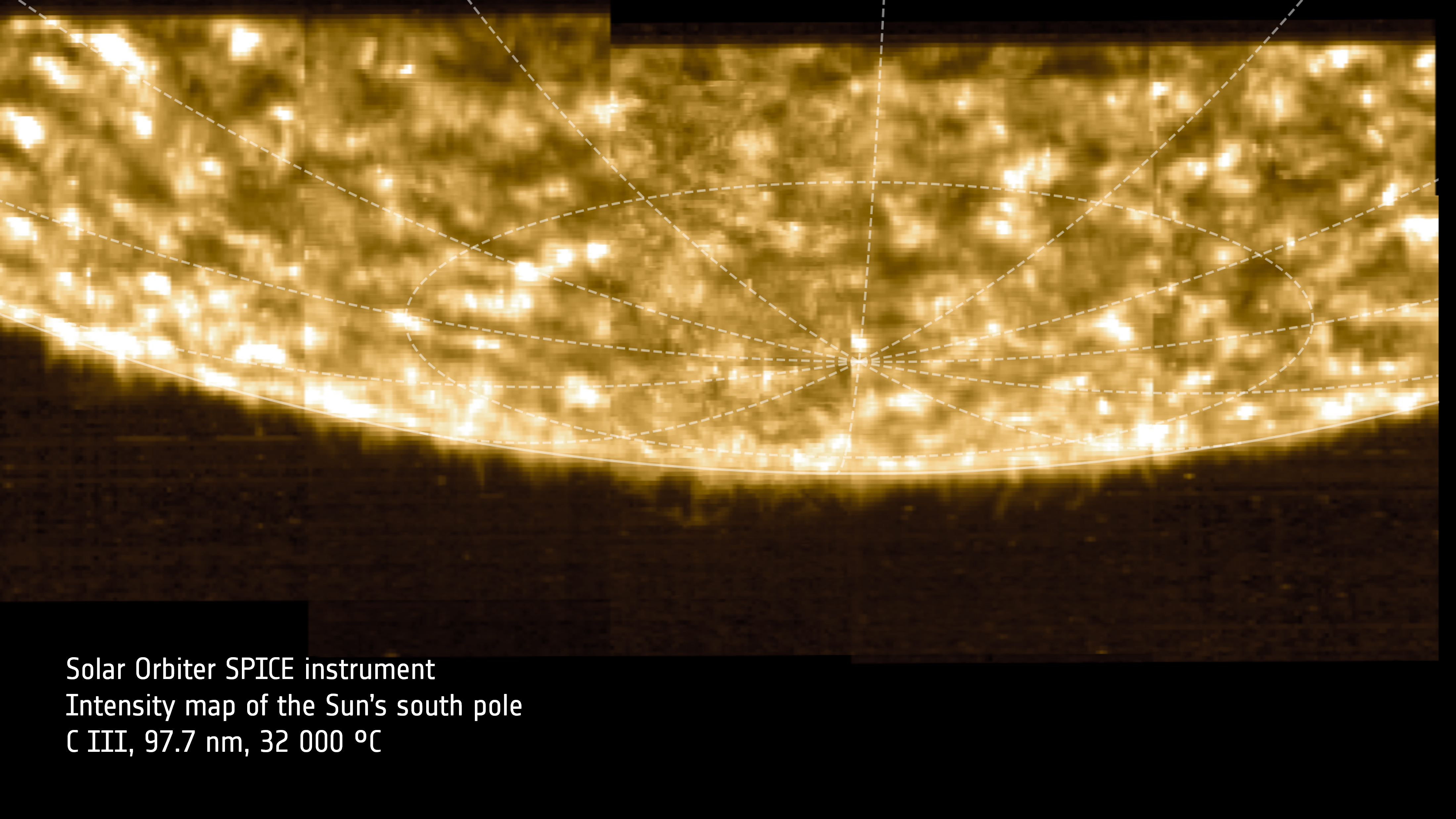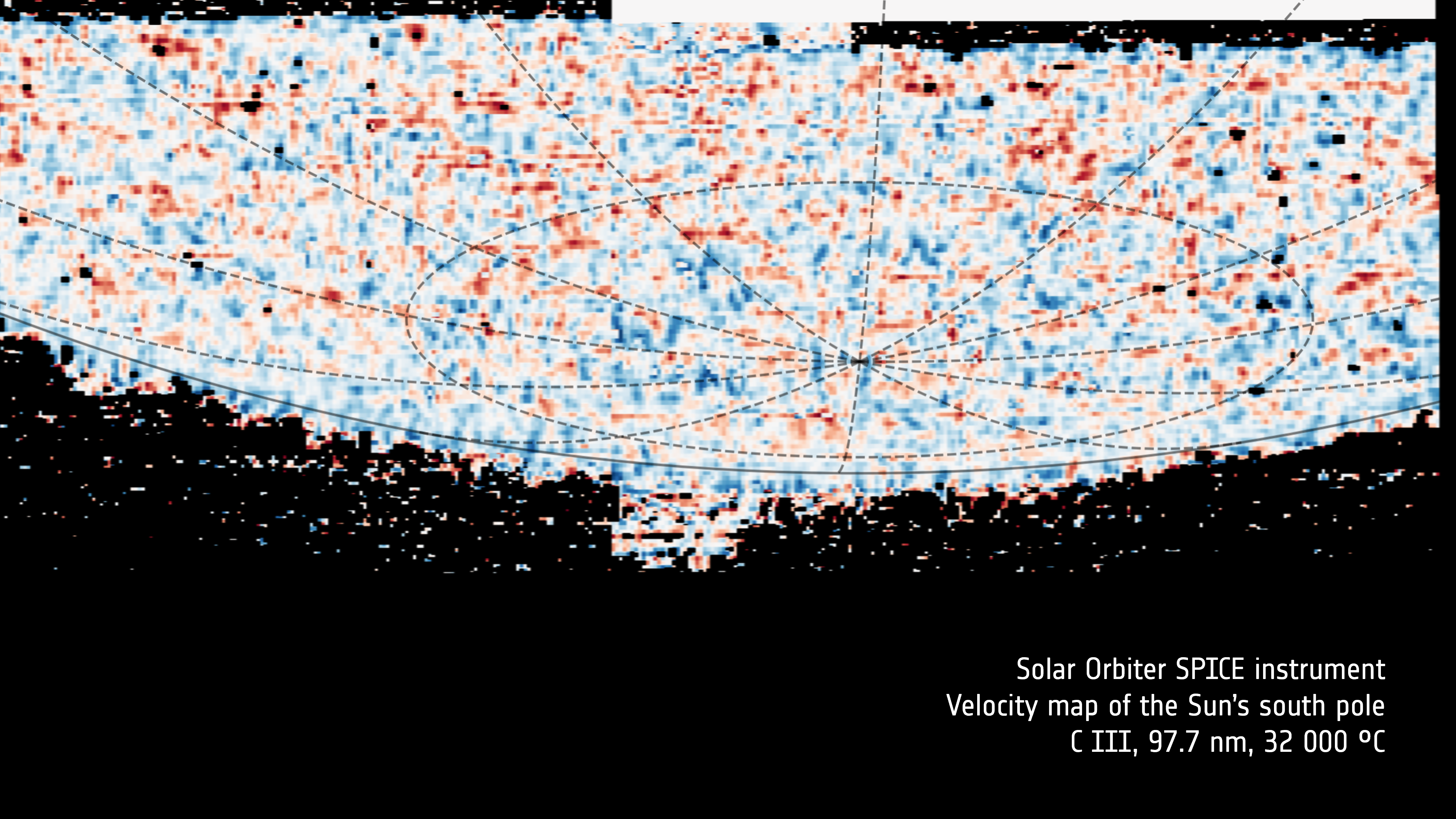This breakthrough comes five years after the mission's launch in February 2020 and marks a significant advance in our understanding of the Sun. Thanks to its newly tilted orbit around the Sun, Solar Orbiter is providing unprecedented views that will transform our understanding of the Sun's magnetic field, the solar cycle and the mechanisms behind space weather.

Solar Orbiter's view of the Sun's south pole. Credit: ESA & NASA/Solar Orbiter/EUI Team, D. Berghmans (ROB)
A Completely New Perspective
Every image you have ever seen of the Sun was taken from around the Sun's equator. This is because Earth, other planets, and all modern Sun-watching spacecraft, orbit within the ecliptic plane. By tilting its orbit out of this plane, Solar Orbiter now reveals the Sun from a whole new angle.
In March 2025, Solar Orbiter viewed the Sun from an angle of 17° below the solar equator, providing a direct view of the Sun's south pole. The best views are yet to come, as the spacecraft's orbit will tilt further in future years.

Solar Orbiter's world-first views of the Sun's south pole. Credit: ESA & NASA/Solar Orbiter/PHI, EUI and SPICE Teams
Revealing Solar Secrets with SPICE
The Spectral Imaging of the Coronal Environment (SPICE) instrument, developed by an international consortium led by RAL Space, is playing a crucial role in these polar observations.
Being an imaging spectrograph, SPICE measures the light (spectral lines) sent out by specific chemical elements – hydrogen, carbon, oxygen, neon and magnesium – at known temperatures. For the last five years, SPICE has used this to reveal what happens in different layers above the Sun's surface.
Now for the first time, the SPICE team has also managed to use precise tracking of spectral lines to measure how fast clumps of solar material are moving. This is known as a 'Doppler measurement', named after the same effect that makes passing ambulance sirens change pitch as they drive by.
“The RAL Space team conceived and defined these SPICE observations of the polar regions, ensuring they are perfectly planned and executed. Further data from the first observations are still being sent back to Earth, and more such studies will follow during the next perihelia", explains Dr Andrzej Fludra, SPICE Co-PI and Solar Physics Programme Lead at RAL Space.
“Our colleagues at the SouthWest Research Institute developed special software to extract the pattern of the velocities of the plasma from SPICE. Measuring the outflowing velocities in the polar regions is important to answer one of the big questions in solar physics: where does the fast solar wind originate?
“Measuring the magnetic fields in these regions will help understand the solar dynamo mechanism that generates the Sun's magnetic fields. The results so far show only a small sample of the capabilities that SPICE can offer in studying the polar regions, and we look forward to future discoveries."


Here we compare two of SPICE's views of the Sun's south pole. The top image shows an intensity map, revealing the locations of clumps of carbon ions. The bottom image shows a velocity map, where blue and red indicate how fast the carbon ions are moving towards and away from the Solar Orbiter spacecraft, respectively. Credit: ESA & NASA/Solar Orbiter/SPICE Team, M. Janvier (ESA) & J. Plowman (SwRI)
Why the Poles Matter
Solar Orbiter's groundbreaking high-latitude observations are key to understanding the Sun's magnetic field and why it flips roughly every 11 years, coinciding with peaks in solar activity. Current models and predictions of the 11-year solar cycle cannot precisely forecast when and how powerfully the Sun will reach its most active state.
Additionally, measurements of the Sun's magnetic field at higher latitudes allow Solar Orbiter to map more of the Sun's global magnetic field as it changes throughout the solar cycle. Early results from the Polarimetric and Helioseismic Imager (PHI) show that the Sun's magnetic field at the south pole is currently in a complex, mixed state.
Looking Ahead
Following a close Venus flyby in February 2025, Solar Orbiter began its new phase of operations with an orbital inclination of 17°. Future Venus gravity assists in 2026 and 2029 will increase this inclination to 24° and eventually 33°, enabling even better views of the poles.
Supported by the UK Space Agency, the SPICE team at RAL Space remains dedicated to ensuring the continued success of science operations through the anticipated end of the mission in 2030.
The international Solar Orbiter team meets regularly to plan upcoming observation campaigns, while all data is made freely available in the ESA archive, providing a valuable resource for the worldwide solar physics community.
Read more about this milestone from the European Space Agency.
